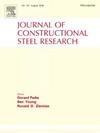Model and uncertainty of compressive load capacity of steel equal angle connected by one leg
IF 4
2区 工程技术
Q1 CONSTRUCTION & BUILDING TECHNOLOGY
引用次数: 0
Abstract
Steel angle often connects with single leg for construction convenience, which introduces uncertainties in load eccentricity and restraint, making capacity complex to calculate precisely. This research aims to establish a stability coefficient distribution pattern applicable for a wide range of section dimensions, and investigate the effect of structural uncertainty on it. Experiments were conducted to validate the FE models. Subsequently, stability coefficients under commonly used section dimensions were obtained, and influencing parameters were evaluated. Sensitivity and uncertainty analyses were employed to study the impact of structural uncertainty. It was found that the stability coefficients of steel angle connected by one leg form a distribution band, for which a mathematical model was developed. Connection plate dimensions had significant influence on the stability coefficient. Considering structural uncertainty, yield strength and element dimensions had notable sensitivity. And the stability coefficients of the steel angle followed a normal distribution with negative skewness. Therefore, the influence of structural uncertainties cannot be underestimated in the analysis of capacity, and this study provides a reference for their quantitative assessment.
单腿连接等边角钢抗压承载力的模型和不确定性
为了施工方便,角钢通常采用单腿连接,这就带来了荷载偏心和约束的不确定性,使承载力的精确计算变得复杂。本研究旨在建立适用于各种截面尺寸的稳定系数分布模式,并研究结构不确定性对其的影响。实验验证了 FE 模型。随后,获得了常用截面尺寸下的稳定系数,并对影响参数进行了评估。采用敏感性和不确定性分析来研究结构不确定性的影响。结果发现,由一条支腿连接的角钢的稳定系数形成了一个分布带,并为此建立了一个数学模型。连接板尺寸对稳定系数有显著影响。考虑到结构的不确定性,屈服强度和元件尺寸具有显著的敏感性。角钢的稳定系数呈负偏态正态分布。因此,在承载力分析中,结构不确定性的影响不可低估,本研究为其定量评估提供了参考。
本文章由计算机程序翻译,如有差异,请以英文原文为准。
求助全文
约1分钟内获得全文
求助全文
来源期刊

Journal of Constructional Steel Research
工程技术-工程:土木
CiteScore
7.90
自引率
19.50%
发文量
550
审稿时长
46 days
期刊介绍:
The Journal of Constructional Steel Research provides an international forum for the presentation and discussion of the latest developments in structural steel research and their applications. It is aimed not only at researchers but also at those likely to be most affected by research results, i.e. designers and fabricators. Original papers of a high standard dealing with all aspects of steel research including theoretical and experimental research on elements, assemblages, connection and material properties are considered for publication.
 求助内容:
求助内容: 应助结果提醒方式:
应助结果提醒方式:


